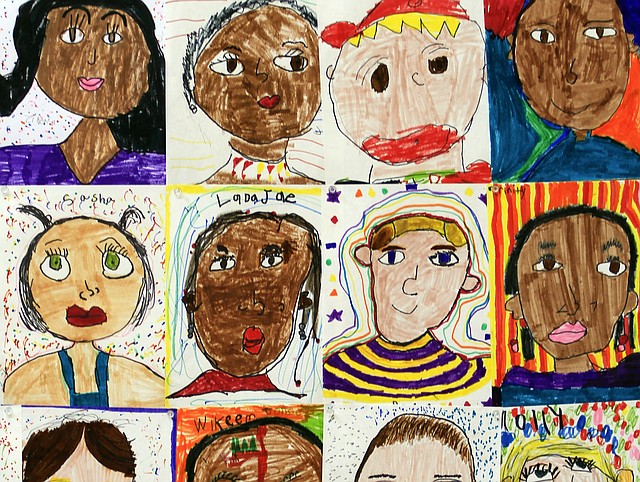Focus on Arts: Learning with the language of art
Sunday, September 9, 2012
Art is everywhere at Battle Academy, a Chattanooga elementary magnet school on Market Street.
Stained glass windows, created by students, decorate the hallways. There are also collages, self-portraits and brightly colored drawings and paintings hung throughout the school. A large rendering of a cell hangs on the wall outside a science classroom.
"Sometimes, the symbols we see as adults make sense, but they aren't child friendly," said Scott Rosenow, magnet, technology and arts education facilitator at Battle.
Using art - visual or performing - allows the children to develop a stronger understanding of life around them, he said.
Rosenow and visual arts instructor Carla Guerra will address these observations at this week's Arts Education Partnership's Fall 2012 National Forum, to be held Thursday and Friday at The Chattanoogan. They will also talk about the family and community relationships vital to maintaining an artistically minded school.
Organizations such as Southeast Center for Education in the Arts, Rosenow said, help "open both our students' and teachers' eyes to the artistic process and its application to our curriculum across grade levels and content areas."
In other words, art helps children learn.
In Carrie Hoover's fourth-grade science class, students moved around a center space to form the parts of a plant cell.
"Boys," Rosenow asked, sitting on the floor with the children, "what are we representing with our arms?"
"Cell wall," they chorused.
"And what do we represent with our legs?"
"The cell membrane."
The goal, Hoover and Rosenow said, was to see if the students could gain a better understanding of how the parts of the cell worked.
The experiment works. Rosenow taps Lily Rosenow, his daughter, and Lily Cooper, curled up on the floor in the middle of the circle. They represent the nucleus of the cell.
"What does the nucleus do?" he asked them.
"It's the control center," Lily Rosenow replied.
The students are able to use art to articulate their experiences, Rosenow said, and therefore enhance their learning. Second-graders learn about African culture by dancing and drumming with guest artist Kofi Mawuko. Fourth-graders create audio-visual slide shows that they narrate themselves to understand bodily systems.
"We can do this arts-embedded work anywhere," Rosenow said. "We really see the students are engaged by that work."
Incorporating artistic, creative elements into learning has helped the students have a stronger understanding of topics such as math and science. Conversely, nonarts topics are often integrated into the arts lessons, often without the students' knowledge.
"A lot of the work that happens in the arts classroom acts as a springboard into the other classrooms," Rosenow said.
In Carla Guerra's second-grade visual arts class, students are re-creating sketches using only straight and curved lines, and making prints from tools made from cut plastic cups and black ink.
Rosenow talks to Dru Marchand about how she will use the line tool and the curve tool to recreate her drawing of a sun and flowers.
Caleb McCullough drew a truck: round wheels, rectangular body.
Rebecca Hanson is making a unicorn named Emily with a large, angular horn.
To the children, it's a fun art project.
But to the teachers, it's an early geometry lesson.
"Mathematically, they are recognizing that there is a difference between a straight and a curved line," said Guerra. "When they go back to their math classroom, they'll remember creating the shapes in the art room."
Arts Education Partnership Fall Forum planners
Lead planning organization:
Southeast Center for Education in the Arts at UTC
• Kim Wheetley, executive director
• Laurie Melnik, director of theatre education
• Joel Baxley, director of visual art education
• Mary LaBianca, director of dance education
• Susanne Burgess, director of music education
• Redeitha Weiss, administrative assistant
Local planning partners:
• Allied Arts of Greater Chattanooga
• Center for Creative Arts
• City of Chattanooga Department of Education, Arts, and Culture
• Chattanooga Convention and Visitors Bureau
• Creative Discovery Museum
• Ensemble Theatre of Chattanooga
• Hamilton County Department of Education
• Hamilton County Government
• McCallie School
• St. Andrews Center
• The 35.85 Guild
• The University of Tennessee at Chattanooga
